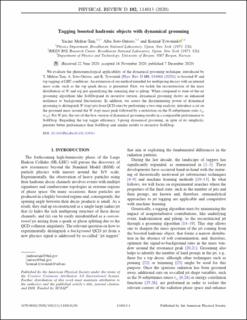Tagging boosted hadronic objects with dynamical grooming
Journal article, Peer reviewed
Published version

Åpne
Permanent lenke
https://hdl.handle.net/11250/2761682Utgivelsesdato
2020Metadata
Vis full innførselSamlinger
Sammendrag
We evaluate the phenomenological applicability of the dynamical grooming technique, introduced by Y. Mehtar-Tani, A. Soto-Ontoso, and K. Tywoniuk [Phys. Rev. D 101, 034004 (2020)], to boosted W and top tagging at LHC conditions. An extension of our method intended for multiprong decays with an internal mass scale, such as the top quark decay, is presented. First, we tackle the reconstruction of the mass distribution of W and top jets quantifying the smearing due to pileup. When compared to state-of-the-art grooming algorithms like SoftDropand its recursive version, dynamical grooming shows an enhanced resilience to background fluctuations. In addition, we assess the discriminating power of dynamical grooming to distinguish W (top) jets from QCD ones by performing a two-step analysis: introduce a cut on the groomed mass around the W (top) mass peak followed by a restriction on the N-subjettinnes ratio τ 21 ( τ 32 ). For W jets, the out-of-the-box version of dynamical grooming results in a comparable performance to SoftDrop. Regarding the top tagger efficiency, 3-prong dynamical grooming, in spite of its simplicity, presents better performance than SoftDrop and similar results to recursive SoftDrop.
